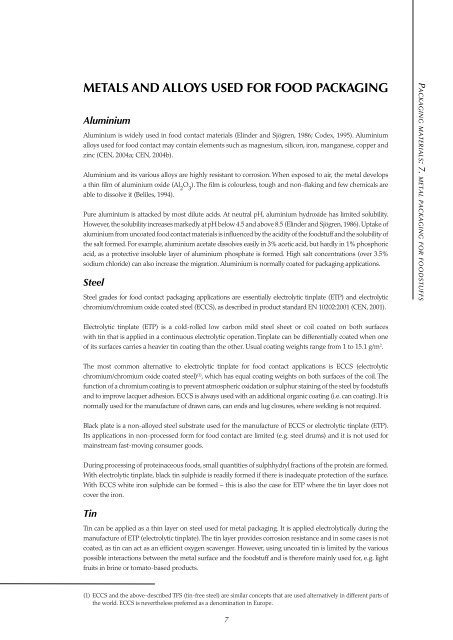packaging materials 7. metal packaging for foodstuffs - Europa
packaging materials 7. metal packaging for foodstuffs - Europa
packaging materials 7. metal packaging for foodstuffs - Europa
You also want an ePaper? Increase the reach of your titles
YUMPU automatically turns print PDFs into web optimized ePapers that Google loves.
METALS AND ALLOYS USED FOR FOOD PACKAGINGAluminiumAluminium is widely used in food contact <strong>materials</strong> (Elinder and Sjögren, 1986; Codex, 1995). Aluminiumalloys used <strong>for</strong> food contact may contain elements such as magnesium, silicon, iron, manganese, copper andzinc (CEN, 2004a; CEN, 2004b).Aluminium and its various alloys are highly resistant to corrosion. When exposed to air, the <strong>metal</strong> developsa thin film of aluminium oxide (Al 2O 3). The film is colourless, tough and non-flaking and few chemicals areable to dissolve it (Beliles, 1994).Pure aluminium is attacked by most dilute acids. At neutral pH, aluminium hydroxide has limited solubility.However, the solubility increases markedly at pH below 4.5 and above 8.5 (Elinder and Sjögren, 1986). Uptake ofaluminium from uncoated food contact <strong>materials</strong> is influenced by the acidity of the foodstuff and the solubility ofthe salt <strong>for</strong>med. For example, aluminium acetate dissolves easily in 3% acetic acid, but hardly in 1% phosphoricacid, as a protective insoluble layer of aluminium phosphate is <strong>for</strong>med. High salt concentrations (over 3.5%sodium chloride) can also increase the migration. Aluminium is normally coated <strong>for</strong> <strong>packaging</strong> applications.SteelSteel grades <strong>for</strong> food contact <strong>packaging</strong> applications are essentially electrolytic tinplate (ETP) and electrolyticchromium/chromium oxide coated steel (ECCS), as described in product standard EN 10202:2001 (CEN, 2001).Pa c k a g i n g ma t e r i a l s: <strong>7.</strong> m e t a l pa c k a g i n g f o r f o o d s t u f f sElectrolytic tinplate (ETP) is a cold-rolled low carbon mild steel sheet or coil coated on both surfaceswith tin that is applied in a continuous electrolytic operation. Tinplate can be differentially coated when oneof its surfaces carries a heavier tin coating than the other. Usual coating weights range from 1 to 15.1 g/m 2 .The most common alternative to electrolytic tinplate <strong>for</strong> food contact applications is ECCS (electrolyticchromium/chromium oxide coated steel) (1) , which has equal coating weights on both surfaces of the coil. Thefunction of a chromium coating is to prevent atmospheric oxidation or sulphur staining of the steel by <strong>foodstuffs</strong>and to improve lacquer adhesion. ECCS is always used with an additional organic coating (i.e. can coating). It isnormally used <strong>for</strong> the manufacture of drawn cans, can ends and lug closures, where welding is not required.Black plate is a non-alloyed steel substrate used <strong>for</strong> the manufacture of ECCS or electrolytic tinplate (ETP).Its applications in non-processed <strong>for</strong>m <strong>for</strong> food contact are limited (e.g. steel drums) and it is not used <strong>for</strong>mainstream fast-moving consumer goods.During processing of proteinaceous foods, small quantities of sulphhydryl fractions of the protein are <strong>for</strong>med.With electrolytic tinplate, black tin sulphide is readily <strong>for</strong>med if there is inadequate protection of the surface.With ECCS white iron sulphide can be <strong>for</strong>med – this is also the case <strong>for</strong> ETP where the tin layer does notcover the iron.TinTin can be applied as a thin layer on steel used <strong>for</strong> <strong>metal</strong> <strong>packaging</strong>. It is applied electrolytically during themanufacture of ETP (electrolytic tinplate). The tin layer provides corrosion resistance and in some cases is notcoated, as tin can act as an efficient oxygen scavenger. However, using uncoated tin is limited by the variouspossible interactions between the <strong>metal</strong> surface and the foodstuff and is there<strong>for</strong>e mainly used <strong>for</strong>, e.g. lightfruits in brine or tomato-based products.(1) ECCS and the above-described TFS (tin-free steel) are similar concepts that are used alternatively in different parts ofthe world. ECCS is nevertheless preferred as a denomination in Europe.7

















